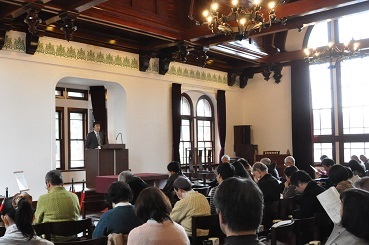Center for Interdisciplinary Study of Monotheistic Religions(CISMOR)Doshisha University
> Public Lectures > The Formation of Yahwistic Monotheism: an Archaeological ApproachPublic Lectures
The Formation of Yahwistic Monotheism: an Archaeological Approach
| Date: |
2016/02/13 13:00-15:00 |
|---|---|
| Place: | Clarke Memorial Hall Chapel, Imadegawa Campus, Doshisha University |
| Lecture: | Sugimoto, David T. (Professor, Keio University) |
| Summary: | |
|
Prof. Sugimoto explained the establishment of ancient monotheism based on archeological evidence. First, he indicated the differences in the nature of the archeological materials and Biblical documents. According to him, the Biblical documents, which remained in written form, were created by individuals in leadership positions in society, such as religious leaders and kings; therefore, the documents tend to contain their preconceptions. By contrast, the details and creators of archeological materials are often unclear, and because a specific individual did not purposely leave them, the information contained in the texts expresses the nature of the era without slightly prejudiced preconceptions. The different characteristics of archeological materials and Biblical documents make it possible to consider a more objective viewpoint. In the Bible, monotheism began with Abraham. The god of the Bible became recognized as Yahweh at the time of Moses. When the people of Israel made their exodus from Egypt and entered Canaan, the people that lived there and engaged in idolatry influenced them. According to the most widely accepted theory among researchers in recent years, monotheism became clearly conceived around the period of Babylonian captivity; prior to this, the Israelites were polytheistic, similar to the Canaanites. Researchers, such as Julius Wellhausen, who maintain a position of early Biblical criticism, regard that during the period of the patriarchs, the Israelites believed in animism and polytheism, which later changed to ethical monotheism during the period of the prophets, and pure monotheism during the period of captivity. The background behind this understanding is the theory of evolution in European society. In essence, according to the theory of primitive monotheism, the gods that originally ruled specific cities reached the pinnacle in the hierarchy of gods due to the expansion of the territories of nation states. There are those who assert that geniuses such as Abraham were established after receiving a revelation, but there are few researchers who subscribe to this theory. The basis for the theory that the Israelites were polytheistic prior to the period of captivity is based on documents written in Ugalit that were discovered in the northern region of Syria. Gods such as El and Asherah appear in this text: El was married to a goddess. Based on these findings, there has been a similar theory that El, the god of the Bible, was married, connecting the religions of the Canaanites and Israelites. An image found in Kuntillet Ajrud, located on the Sinai Peninsula, depicts the image of two standing people with the heads of animals. The images overlap, and an inscription reads, "I have blessed you by Yahweh of Samaria and [his] Asherah." The people who found these two images of cows thought that they were Yahweh and Asherah. In response to this, Dr. Sugimoto believes that because these cows had no horns and, although it should be important that the cows were found in a pair, because a third figure of a person playing a harp was found next to them, it is difficult to believe that the figures represent Yahweh and Asherah. Currently, it has also been questioned if it is necessary to read the inscription as "Yahweh and his wife Asherah." In light of the fact that pronouns cannot be used for gods in Biblical Hebrew grammar, he is of the opinion that the expression "his Asherah" does not refer to the goddess, but rather should be understood as “the tree of life.” According to Dr. Sugimoto’s understanding concerning the archaeological materials, after the period around 1200 BCE when the Israelites first appeared in history, the image of the goddess Asherah remained unclear for the next 200 years. While the tree of life is a symbol used during the Canaan era, it contained no elements related to a goddess, and the elements related to fertility of Asherah were incorporated into Yahweh. Finally, by the 9th century BCE, the symbol of the tree of life itself was considered idolatrous and was, therefore, rejected. In essence, because the phenomenon of incorporation refers to the act of stealing the attributes of other gods, a comprehensive monotheistic concept developed, subsequently leading to exclusive monotheism. Kotaro Hiraoka Postdoctral Fellow, CISMOR |
|
|
*Admission Free, No Reservation Necessary. *Lecture in Japanese. |
|

